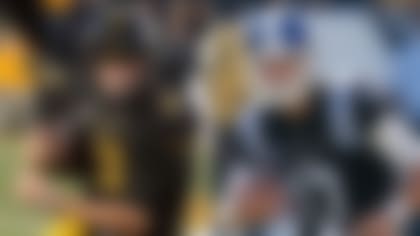Editor's note: NFL.com analysts and former NFL scouts Daniel Jeremiah and Bucky Brooks of the Move The Sticks Podcast share some of their scouting notes, including:
But first, we kick off this week's notebook with Brooks' look at how the evolution of some NFL offenses could benefit the next wave of passers to enter the league.
It has taken a while for NFL coaches and executives to embrace the spread offense and various read-option concepts that accompany it, but the 2018 quarterback class could benefit from the evolution that's occurring in the pro game. Coaches are beginning to sprinkle in some core schemes from the college offenses to help their QB1s, particularly young quarterbacks, find their groove as playmakers.
Look no further than the exceptional job Houston Texans head coach Bill O'Brien has done with Deshaun Watson as proof of the evolution. The veteran coach is as old school as it gets when it comes to his offensive philosophy, but he has embraced a number of the concepts that were featured in the Clemson playbook. Part of his rationale stems from his desire to build the offense around the strengths of his No. 1 playmaker.
"I think coaching's about trying to make sure you understand what the player's skill set is, especially at that position, and then looking at your offense relative to that," O'Brien said during a press conference earlier this month, per the Houston Chronicle. "It's not the other way around: 'Hey look, this is what we do. You've got to fit what we do.'"
But O'Brien is not alone in embracing the spread offense to enhance the play of his QB1, as we have seen the Tennessee Titans, Kansas City Chiefs, Seattle Seahawks and Carolina Panthers roll out a number of plays that are straight out of a college playbook. Whether it's the speed option, shovel pass or an assortment of RPOs (run-pass options), we have seen more NFL teams utilizing plays that were typically reserved for Saturday afternoons.
Thus, the argument regarding the NFL readiness of quarterbacks coming from spread offenses in college is beginning to lose some steam based on the success that creative NFL play callers have enjoyed with spread quarterbacks this year. The next wave of QBs could step into a league that is far more friendly to spread QBs than it was to their predecessors.
NFL coaches are showing more flexibility and adaptability with their schemes, which bodes well for guys who spent three or four years directing offenses that are vastly different than the traditional systems that are prevalent in the pros. Guys like USC's Sam Darnold, Oklahoma's Baker Mayfield, Oklahoma State's Mason Rudolph, Louisville's Lamar Jackson and Washington State's Luke Falk fall into the spread-quarterback category. Although each of their respective systems is different, they feature a ton of shotgun formations and read-option concepts that usually prompt evaluators to pause before fully endorsing their pro potential as QB1s.
Of course, there are still coaches who absolutely hate the notion of a college QB playing the role of a joystick for a micro-managing offensive coordinator who controls the game from the sidelines through poster boards and signals. Arizona Cardinals coach Bruce Arians has bemoaned that situation in recent years.
"So many times, you're evaluating a quarterback who has never called a play in the huddle, never used a snap count. They hold up a card on the sideline, he kicks his foot and throws the ball," Arians said during the 2015 NFL Scouting Combine. "That ain't playing quarterback. There's no leadership involved there. There might be leadership on the bench, but when you get them and they have to use verbiage and they have to spit the verbiage out and change the snap count, they are light years behind."
Despite Arians' sentiments, which echo the views of several old-school coaches, the immediate success of Marcus Mariota, Russell Wilson and Cam Newton directing collegiate-like spread offense at the NFL level should encourage more teams to consider modifying their developmental approach.
We'd be remiss to fail to note the radical improvement in Alex Smith's play since moving to Kansas City under a flexible offensive architect in Andy Reid. That should serve as a long-term blueprint for transitioning a spread quarterback into an NFL system. The veteran has played at an MVP level this season while directing an offense that not only features core elements of the spread (Smith ran a version of the spread at Utah) but also showcases Reid's West Coast offense background.
With Watson also emerging as a front-runner to the NFL's Offensive Rookie of the Year Award with 17 total touchdowns (15 passing; 2 rushing) and a 101.1 passer rating directing a modified version of the spread, it might be time for the NFL to roll out the red carpet for the next generation of spread quarterbacks set to enter the league in 2018. --Bucky Brooks
5 QUESTIONS FOR THE SECOND HALF
As we enter the second half of the college football season, here are 5 big questions that will be answered:
1. Can Sam Darnold solve his ball security issues? While most pundits point to the USC QB's interception woes, I'm actually more concerned with his fumbles. He's had issues holding onto the ball when bodies are around him in the pocket. That's just sloppy play. He'll need to clean that up, starting this Saturday at Notre Dame.
2. Will Josh Rosen rally the Bruins to a strong finish? I know some folks hate this point, but winning matters at the quarterback position. In draft meetings, it's much easier to sell a quarterback coming off a 9-10 win season than it is to justify why this "elite" player could only muster 4-5 wins last season. Rosen hasn't played poorly this year, but he has been a little inconsistent. The major issues at UCLA are on the defensive side of the ball. However, evaluators will be closely following Rosen to see if he can overcome some shortcomings on the roster and help lead UCLA to a strong finish.
3. Can Josh Allen improve his decision making? The Wyoming signal-caller is the most talented quarterback in the country. He has a rare blend of size, arm strength and athleticism. However, he's been plagued by 2-3 poor decisions in almost every game this fall. He doesn't have a very gifted supporting cast on this year's squad and he's been prone to force things at times. I've seen a steady improvement in this department over the last few weeks. Let's see if he can keep it going.
4. Who's the best defensive back in college football, Alabama's Minkah Fitzpatrick or FSU's Derwin James? This is a question being asked by evaluators across the Southeast. Fitzpatrick and James are both unique talents. Fitzpatrick offers more man coverage ability while James is a better force player around the line of scrimmage. Alabama will have more high-profile contests down the stretch, but there are still plenty of opportunities for James to put on a show for scouts.
5. Can Bryce Love keep up this pace? While so much attention has focused -- rightfully -- on Saquon Barkley's outstanding play this fall, Stanford's Bryce Love has put up video-game numbers for the Cardinal. He's averaging 10.3 yards per carry. That's insane! I've already had a couple scouts tell me he's been the biggest surprise in college football this fall. We'll get a better feel for just how special he is down the stretch. -- Daniel Jeremiah
BEGINNING OF A FIRST-ROUND PUSH?
I can't wait to watch Michigan and Penn State square off on Saturday night. Penn State RB Saquon Barkley is clearly the top prospect in the game, but one of the more intriguing players in the contest plays along the defensive front for the Wolverines -- DT Maurice Hurst.
Hurst is an undersized interior defender (scouts measured him in the spring at 6-foot-1 3/8 and 287 pounds) who relies on quickness and instincts to make plays against both the run and pass. After studying tape of him, I think he's ideally suited to play in an aggressive scheme that allows him to attack rather than sitting and holding the point of attack. He will have a hard time holding up vs. double teams, and that would negate his greatest weapon, which is his first-step quickness.
Most evaluators believe he isn't likely to be selected in the first round of the 2018 NFL Draft, but a big game against Penn State could be the first step in changing their opinion. -- Daniel Jeremiah
UNDER-THE-RADAR RB TO WATCH
I spent some time studying Notre Dame's offensive line a few weeks ago and I came away impressed with their group. They are a physical bunch, featuring one of the best interior linemen (Quenton Nelson) as well as one of the top offensive tackles (Mike McGlinchey) in the country.
The biggest benefactor of their dominant play is running back Josh Adams.
For a bigger back (he's listed at 6-2 1/8 and 225 pounds), Adams has a nice initial burst and he's also capable of making the free man miss in the open field. He's averaging a ridiculous 9 yards per carry this season. I don't put him in the same class as guys like Penn State's Saquon Barkley and LSU's Derrius Guice. He's not nearly as explosive or dynamic as those RBs, but he is a very capable runner with outstanding size and production. It will be interesting to see which running back has the bigger game in South Bend this weekend. USC's Ronald Jones is highly coveted by NFL scouts and he brings a home-run element to the Trojans' offensive attack. -- Daniel Jeremiah
Follow Bucky Brooks on Twitter @BuckyBrooks.








